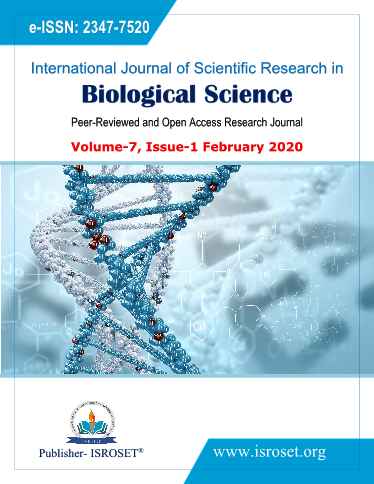In Vitro Propagation of Endangered Medicinal Plant Ormocarpum Sennoides (Willd.) DC From Internodal Segments
Keywords:
Ormocarpum sennoides, endangered medicinal plant, hardeningAbstract
An efficient regeneration protocol was established for in vitro propagation through direct and indirect regeneration of Ormocarpum sennoides from internodal explants. Murashige and Skoog (MS) medium supplemented with different concentrations of 6-benzyladenine amino purine (BAP), 2, 4 Dichlorophenoxy acetic acid (2,4-D), Indole-3-acetic acid (IAA) and Napthalene acetic acid (NAA) either alone or in combinations. Indirect regeneration, MS medium supplemented with D1: BAP 2.5 mg/L has shown the highest regeneration percentage of 88.9% with shoot length of 8.36 cm and root length of 1.52 cm. In indirect regeneration I4: BAP 2.0 mg/L + IAA 3.0 mg/L has shown the highest callus induction percentage of 86.7% and maximum callus weight of 1.03g. The highest frequency of shoot regeneration (68.3%) with maximum shoot length (3.53 cm) was observed in MS medium supplemented with IS5: BAP 3.5 mg/L. The highest frequency of root regeneration (56.1%) with maximum root length (1.53 cm) was observed in MS medium supplemented with IR5: IAA 2.5 mg/L + NAA 1.0 mg/L. The in vitro derived rooted plantlets were successfully hardened and were acclimatized in the greenhouse.
References
J.K. Grover, S. Yadav, V. Vat, “Medicinal plants of India with antidiabetic potential,” Journal of Ethnopharamacol, Vol. 81, pp. 81-100, 2002.
J.B. Calixto, “Efficacy, safety, quality control, marketing and regulatory guidelines for herbal medicines (phytotherapeutic agents),” Brazil Journal of Medical Biology Research, Vol. 33, pp. 179-189, 2000.
T. Rathakrishnan, “Traditional Agricultural Practices: Applications & Technical Implementations,” New India Publishing, pp. 210, 2009.
Subodh Kapoor. “The Indian Encyclopedia: Biographical, Historical, Religious, Administrative, Ethnological, commercial and scientific,” Genesis Publishing Pvt. Ltd., pp. 5353, 2002.
S. Srividya, T. P. Sastry, B. Santhosh Kumar, T. Hemalatha, “Osteopotential bone-implant containing porous biphasic calcium impregnated with casein, egg yolk, and Ormocarpum sennoides- An in vitro study,” International Journal of Pharma and Bio Sciences, Vol. 6, Issue. 1, pp. 275-282, 2015.
S. Sukasini, M. Bhargav Iyer, S. Sakthi Priyadarshini, P.R. Kumar, ”Retrospect of Ormocarpum sennoides (willd.) DC: A Boon to phytomedicine,” Global Journal of Research on Medicinal Plants & Indigenous Medicine, Vol. 4, Issue. 10, pp. 203-208, 2015.
Saikat Paul, Aryadeep Roychoudhury, “Comparative Analyses of Regeneration Potentiality of Eight Indigenous Aromatic Indica rice (Oryza sativa L.) Varieties,” International Journal of Scientific Research in Biological Sciences, Vol.6, Issue.1, pp.55-64, 2019.
P. Shanthi, “In vitro Propagation of Ormocarpum sennoides (willd) DC Prodr. from shoot tip explants”, Indian Journal of plant physiology, Vol. 13, Issue.1, pp.29-32, 2008.
T. Murashige, F. A. Skoog, “A revised medium for rapid growth and bioassays with tobacco tissue culture,” Plant Physiol, Vol. 15, pp. 473-497, 1962.
U. Thiripurasundari, M.V. Rao, “Indirect organogenesis from nodal explants of Coccinia grandis (L.) Voigt,” Indian Journal of Biotechnology, Vol. 11, pp. 352-354, 2012.
M. Anita, “Effect of plant growth regulators on callus multiplication and in vitro plant regeneration in Bacopa monnieri L,” International Journal of Medicinal Plants Research, Vol. 6, Issue. 5, pp. 337-345, 2017.
R. Sujithra Devi, J. Anbumalarmathi, S. Aruna Sharmili, K. R. Santhiya, “Callus induction and micropropagation in Phyllanthus amarus,” International Journal of Herbal Technology, Vol. 1, Issue. 1, pp. 23-26, 2016.
Ankita R. Patel, Kaplesh B. Ishnava, “In vitro Shoot Multiplication from nodal explants of Coccinia garcinii – an important medicinal climber,” International Journal of Current Biotechnology, Vol. 2, Issue. 2, pp. 16-20, 2015.
Downloads
Published
How to Cite
Issue
Section
License

This work is licensed under a Creative Commons Attribution 4.0 International License.
Authors contributing to this journal agree to publish their articles under the Creative Commons Attribution 4.0 International License, allowing third parties to share their work (copy, distribute, transmit) and to adapt it, under the condition that the authors are given credit and that in the event of reuse or distribution, the terms of this license are made clear.







